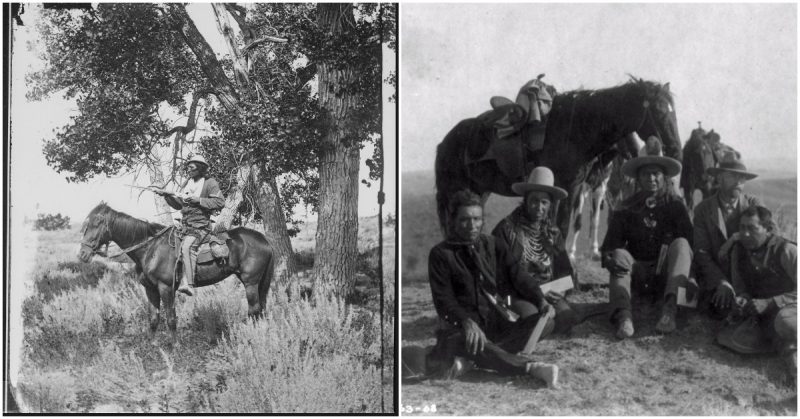It is generally accepted that the Native Americans suffered terribly from the western movement of White Americans, but it is a misconception that all Native Americans tribes were peace-loving people who only fought as a last resort. Many Native tribes had proud traditions of battles and raids on other tribes and fought aggressively against the U.S.
By 1876, many Natives were forced on reservations through unfair treaties or outright diplomatic treachery. A few groups, mainly parts of the Lakota-Sioux and Cheyanne, grouped together outside of their proposed reservations to maintain their independence. The U.S. Army was tasked with rounding up the Indians and forcibly escorting them to their reservations.
In an effort to find and contain the natives, the large army group separated into branching columns. The 7th cavalry under Lieutenant-Colonel George Armstrong Custer was given orders to march out in a reconnaissance role with the additional message for Custer telling him to depart from the original orders if he had good reason to do so.
In what has been seen as a grave mistake, Custer declined to take Gatling guns along, but these would have severely slowed his force down and considering the expected nature of the upcoming battle they may not have been able to make an impact on the outcome.
Custer was given reports of a large village ahead, with a large number of hostile Sioux, near the Bighorn River, by scouts. He took some time to decide on an action. Some say that he was eager to attack, but it seemed that his native scouts urged him to attack as they told him that the Indians in the camp had surely seen Custer’s force and would flee or attack at any time. Custer decided to attack.
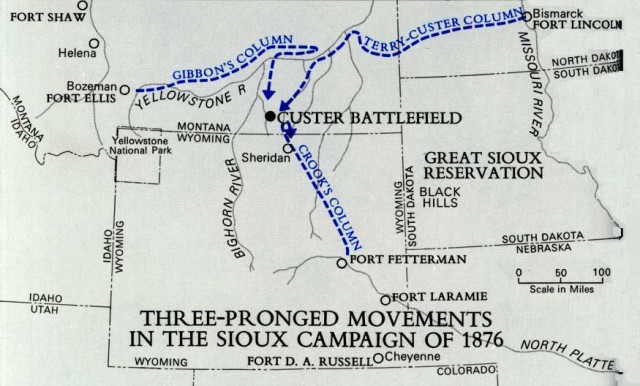
Custer had reports that the village ahead was one of the largest ever assembled, but previous reports before the march gave officers intelligence to expect around 800 warriors. Little did they know that the Lakota Sioux camp under Sitting Bull’s leadership, had been reinforced by many full tribes and parts of tribes, some were attending religious festivities, others had escaped from the reservations. Custer had just under 650 men and could have reasonably expected to win a pitched battle against 800 warriors. His intelligence was wrong and in reality at least 1,000 and as many as 2,500 warriors were at the Bighorn camp.

Custer’s plan was to divide his army, sending three companies under Commander Reno to attack heading northeast, three under Commander Benteen to swing southward and the remaining under Custer himself to swing wide to the north. Custer has long been criticized for splitting his force, but it was a standard tactic of the day intended to confuse and flank enemy forces. It was also used to trap fleeing forces, and Custer was confident that the Natives would be most likely to run away.
One of the larger controversies of the battle was whether or not Sitting Bull, Crazy Horse, and the camp, in general, knew that Custer was near or coming to attack. Seeing how the end result was a catastrophic defeat for Custer, it has often been assumed that the native’s tactics were prearranged. In reality, it seems that they were completely unaware of Custer’s plan to engage them in the middle of the day. Other interviews with warriors in the camp tell stories of men and women rushing into camps shouting the alarm that white men were charging. Indicating that Custer’s attack was a complete surprise.
The first action was fought by Reno’s column, which advanced to the edge of the main camp and began firing. This was part of the proposed strategy of Custer’s that sought to seize the non-combatants or to use them as human shields. as soon as Reno realized the size of the camp, however, he stopped and formed a defensive firing line stationed on his right by the forests along the river.
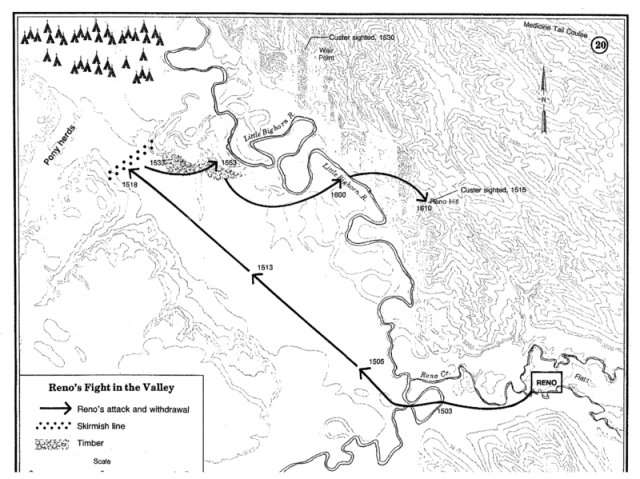
After about 20 minutes of long-range volleys the native warriors formed a counterattack shielded by a hill to Reno’s front left. The natives charged towards Reno’s exposed left with as many as 500 warriors and forced a hasty retreat into the wooded areas by the river.
Reno gave multiple orders to mount, dismount and mount again and seemed indecisive, while his men were desperately holding their positions. Finally, he decided to lead a full retreat, but did not bother to send concise orders for it resulting in a disorganized retreat where many more troopers were killed.
Here is the next point of controversy; Reno was known to have a drinking problem and prior to the engagement seems to have taken several drinks from his flask and soldiers reported that his voice was slurred. Reno was also shocked by the aggressive counterattack, and one of his scouts was shot in the head as they were discussing their next moves.
So it is possible that Reno’s indecision was prompted by his drunkenness or simply that he was flustered by combat or both played a role. Reno’s division was able to retreat to a hilltop, later dubbed Reno’s hill and there they hoped to hold out.
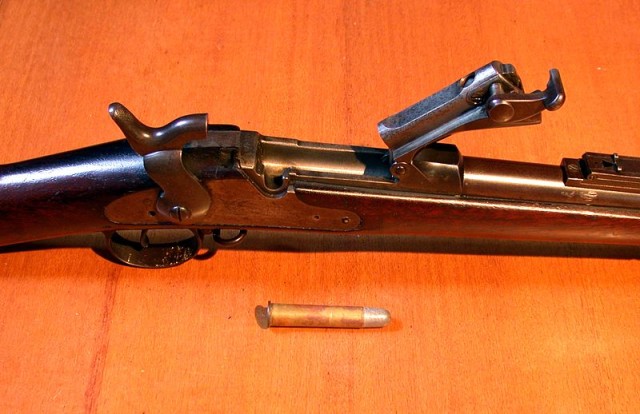
Custer meanwhile heard the shots, but only assumed that Reno’s division had had a successful engagement with the enemy and, therefore, continued his planned northern flanking maneuver. As he sensed the scale of the village he sent a hastily written message to Benteen that literally stated “Benteen. Come on, Big Village, be quick, Bring packs.”
Benteen rode up just in time to save Reno’s shaken force and had no option but to dig in on Reno’s Hill to stop the now furious onslaught. Men used whatever tools they had, including eating utensils, to create firing positions and hope for reinforcements. It has been said that Benteen should have made more of an effort to reinforce Custer, but when taking into account the ineffectual command of Reno, leaving may well have meant the destruction of Reno’s force.
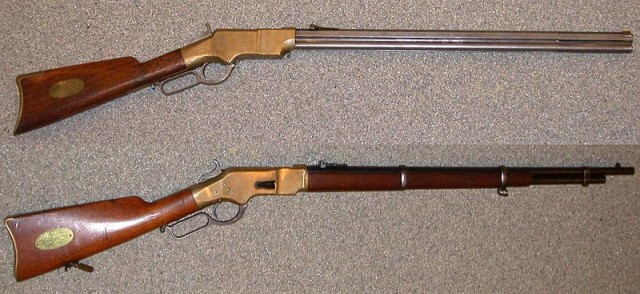
Many elements of the battle so far are recounted from both Sioux and U.S. accounts, but for Custer’s last stand there are several contradictory accounts from natives and the U.S. soldiers. This is because many could only recall hearing the distant firefight and seeing the bodies after the battle.
It seems that Custer decided to follow his own favorite strategy and charged right at the village. His wide flanking maneuver seems to have successful in part as many Natives recounted having to hurry over to defend the other side of their camp. If Custer was hoping to defeat the Sioux and the other Indians by seizing the camp he was badly mistaken, as swift counterattacks forced him back up towards the ridge he rode down from.
As the Custer’s charge faltered and was repulsed, several hundred warriors, supposedly under the command of Crazy Horse, took their own wide flanking route to the northeast. As Custer’s force slowly retreated they were hit hard by this force and had to halt to set up defensive positions. Soldiers shot their horses to use them as defensive positions as men fell by the dozens. Custer himself seems to have put up quite a fight as his personal weapon had several shell casings around his body. He was eventually shot in the chest and the head. The last stand lasted anywhere from a few minutes to as long as an hour, depending on the various accounts.
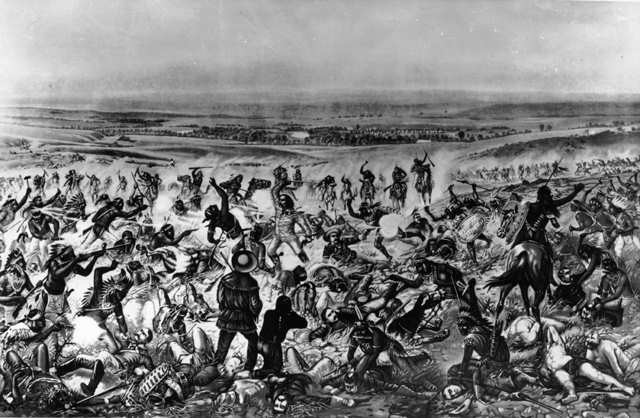
The surrounded divisions of Benteen and Reno were finally rescued by other elements of the army and the natives knew that they had won all they could for the moment and retreated. Custer’s initial force of 650 men had lost 268, including Custer’s whole flanking unit. The natives also suffered heavy casualties, likely several hundred. This is because Custer’s tactics did achieve surprise and divided the Native forces, but the ferocity of the tribes’ counterattacks, their refusal to break, and their superior numbers won the day.
Even when he was alive, Custer was a polarizing figure with roughly equal numbers of his subordinates and superiors greatly admiring him or hating him. Benteen and Reno were known to dislike Custer, and though not likely, it may have been a factor in the battle as Custer faced a relentless attack unsupported.
Today, Custer is no less controversial; his strategies of directing assaults at Native civilians was detestable, but not irrational. His flanking attack would likely have been copied exactly by many other commanders of the day given the same incorrect information. Many think Custer arrogantly rode into a deathtrap while others view it as a mistake because of poor intelligence gathering, or they believe his defeat was because of the swift and effective Native counterattacks.
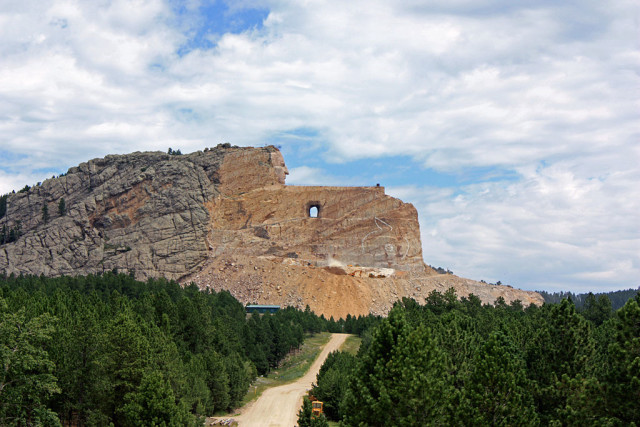
Custer’s greatest chance for success likely would have relied on him scouting the camps location and attacking with his combined force (including the earlier refused Gatling guns) along the route, the Reno’s division had taken. With the right flank guarded by the forest, the left flank could have been stretched to the hill and defended by the Gatling guns. Seeing as Reno’s attack did surprise many of the combatants, such a forceful attack likely would have succeeded, or at the very least afforded a much easier and organized retreat.
Hindsight is 20/20, and the natives at Little Bighorn had brave warriors and quick-witted commanders who took the fight back to their enemy, at least for the moment. The world’s largest monument is presently under construction in the Black Hills to celebrate the boldness and independent spirit of Crazy Horse at the battle of Little Bighorn and his many other battles.
The Battle of the Little Bighorn still fascinates many in America and beyond and is possibly one of the most famous battles in modern history.
By William McLaughlin for War History Online
